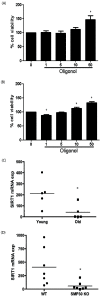Oligonol promotes anti-aging pathways via modulation of SIRT1-AMPK-Autophagy Pathway
- PMID: 26865910
- PMCID: PMC4742308
- DOI: 10.4162/nrp.2016.10.1.3
Oligonol promotes anti-aging pathways via modulation of SIRT1-AMPK-Autophagy Pathway
Abstract
Background/objectives: Oligonol, mainly found in lychee fruit, is an antioxidant polyphenolic compound which has been shown to have anti-inflammatory and anti-cancer properties. The detailed mechanisms by which oligonol may act as an anti-aging molecule have not been determined.
Materials/methods: In this study, we evaluated the ability of oligonol to modulate sirtuin (SIRT) expression in human lung epithelial (A549) cells. Oligonol was added to A549 cells and reactive oxygen species production, mitochondrial superoxide formation, and p21 protein levels were measured. Signaling pathways activated upon oligonol treatment were also determined by western blotting. Furthermore, the anti-aging effect of oligonol was evaluated ex vivo in mouse splenocytes and in vivo in Caenorhabditis elegans.
Results: Oligonol specifically induced the expression of SIRT1, whose activity is linked to gene expression, metabolic control, and healthy aging. In response to influenza virus infection of A549 cells, oligonol treatment significantly up-regulated SIRT1 expression and down-regulated viral hemagglutinin expression. Oligonol treatment also resulted in the activation of autophagy pathways and the phosphorylation of AMP-activated protein kinase (AMPK). Furthermore, oligonol-treated spleen lymphocytes from old mice showed increased cell proliferation, and mRNA levels of SIRT1 in the lungs of old mice were significantly lower than those in the lungs of young mice. Additionally, in vivo lethality assay revealed that oligonol extended the lifespan of C. elegans infected with lethal Vibrio cholerae.
Conclusions: These data demonstrated that oligonol may act as an anti-aging molecule by modulating SIRT1/autophagy/AMPK pathways.
Keywords: Oligonol; SIRT1; aging; senescence.
Figures






Similar articles
-
Oligonol a low molecular weight polyphenol of lychee fruit extract inhibits proliferation of influenza virus by blocking reactive oxygen species-dependent ERK phosphorylation.Phytomedicine. 2010 Nov;17(13):1047-56. doi: 10.1016/j.phymed.2010.03.016. Phytomedicine. 2010. PMID: 20554190
-
Oligonol, a Low-Molecular Weight Polyphenol Derived from Lychee, Alleviates Muscle Loss in Diabetes by Suppressing Atrogin-1 and MuRF1.Nutrients. 2017 Sep 20;9(9):1040. doi: 10.3390/nu9091040. Nutrients. 2017. PMID: 28930190 Free PMC article.
-
Low-Molecular-Weight Oligonol, a Polyphenol Derived from Lychee Fruit, Attenuates Experimental Reflux Esophagitis and HCl/Ethanol-Induced Gastric Ulcer.J Med Food. 2017 Dec;20(12):1214-1221. doi: 10.1089/jmf.2017.3972. J Med Food. 2017. PMID: 29243969
-
Antagonistic crosstalk between NF-κB and SIRT1 in the regulation of inflammation and metabolic disorders.Cell Signal. 2013 Oct;25(10):1939-48. doi: 10.1016/j.cellsig.2013.06.007. Epub 2013 Jun 11. Cell Signal. 2013. PMID: 23770291 Review.
-
AMP-activated protein kinase (AMPK) controls the aging process via an integrated signaling network.Ageing Res Rev. 2012 Apr;11(2):230-41. doi: 10.1016/j.arr.2011.12.005. Epub 2011 Dec 15. Ageing Res Rev. 2012. PMID: 22186033 Review.
Cited by
-
Defective recruitment of motor proteins to autophagic compartments contributes to autophagic failure in aging.Aging Cell. 2018 Aug;17(4):e12777. doi: 10.1111/acel.12777. Epub 2018 May 29. Aging Cell. 2018. PMID: 29845728 Free PMC article.
-
Polyphenols as Caloric-Restriction Mimetics and Autophagy Inducers in Aging Research.Nutrients. 2020 May 8;12(5):1344. doi: 10.3390/nu12051344. Nutrients. 2020. PMID: 32397145 Free PMC article. Review.
-
Tucum-do-Cerrado (Bactris setosa Mart.) May Promote Anti-Aging Effect by Upregulating SIRT1-Nrf2 Pathway and Attenuating Oxidative Stress and Inflammation.Nutrients. 2017 Nov 14;9(11):1243. doi: 10.3390/nu9111243. Nutrients. 2017. PMID: 29135935 Free PMC article.
-
Treatment with autophagic inhibitors enhances oligonol‑induced apoptotic effects in nasopharyngeal carcinoma cells.Biomed Rep. 2024 Aug 5;21(4):143. doi: 10.3892/br.2024.1831. eCollection 2024 Oct. Biomed Rep. 2024. PMID: 39161943 Free PMC article.
-
Neuroprotective effects of hesperetin on H2O2-induced damage in neuroblastoma SH-SY5Y cells.Nutr Res Pract. 2023 Oct;17(5):899-916. doi: 10.4162/nrp.2023.17.5.899. Epub 2023 Jul 19. Nutr Res Pract. 2023. PMID: 37780221 Free PMC article.
References
-
- Fujii H, Sun B, Nishioka H, Hirose A, Aruoma OI. Evaluation of the safety and toxicity of the oligomerized polyphenol Oligonol. Food Chem Toxicol. 2007;45:378–387. - PubMed
-
- Tomobe K, Fujii H, Sun B, Nishioka H, Aruoma OI. Modulation of infection-induced inflammation and locomotive deficit and longevity in senescence-accelerated mice-prone (SAMP8) model by the oligomerized polyphenol Oligonol. Biomed Pharmacother. 2007;61:427–434. - PubMed
-
- Kundu JK, Hwang DM, Lee JC, Chang EJ, Shin YK, Fujii H, Sun B, Surh YJ. Inhibitory effects of oligonol on phorbol ester-induced tumor promotion and COX-2 expression in mouse skin: NF-kappaB and C/EBP as potential targets. Cancer Lett. 2009;273:86–97. - PubMed
-
- Lee SJ, Chung IM, Kim MY, Park KD, Park WH, Moon HI. Inhibition of lung metastasis in mice by oligonol. Phytother Res. 2009;23:1043–1046. - PubMed
-
- Park CH, Noh JS, Fujii H, Roh SS, Song YO, Choi JS, Chung HY, Yokozawa T. Oligonol, a low-molecular-weight polyphenol derived from lychee fruit, attenuates gluco-lipotoxicity-mediated renal disorder in type 2 diabetic db/db mice. Drug Discov Ther. 2015;9:13–22. - PubMed
LinkOut - more resources
Full Text Sources
Other Literature Sources

